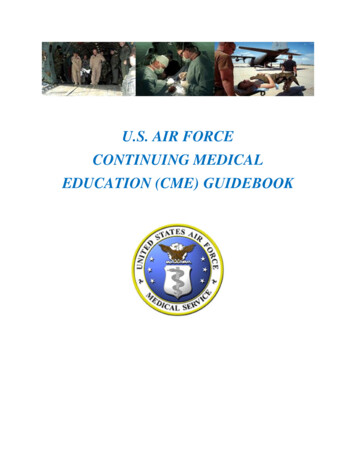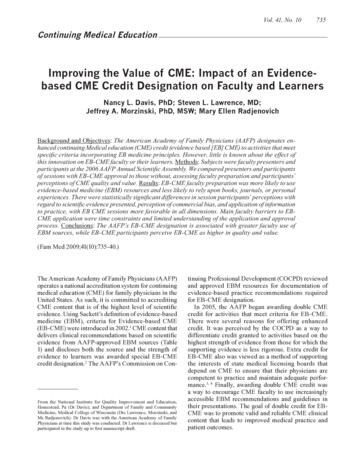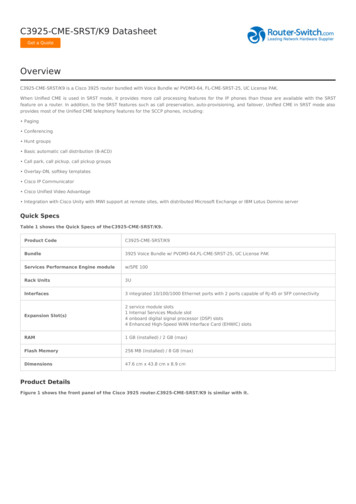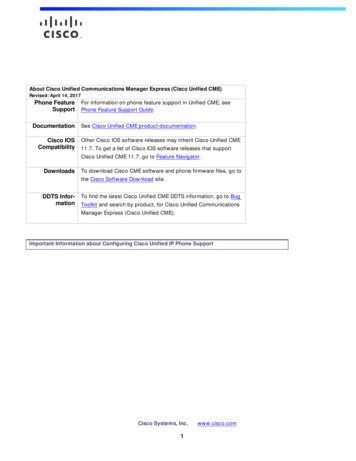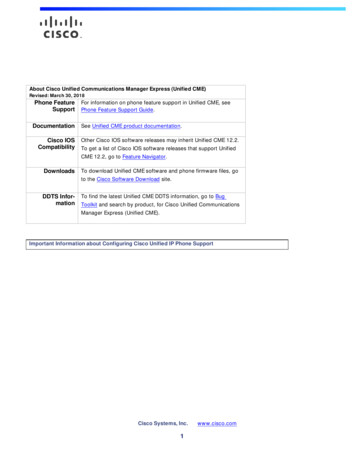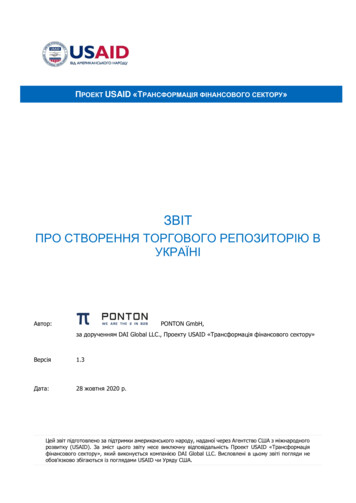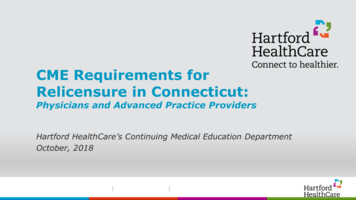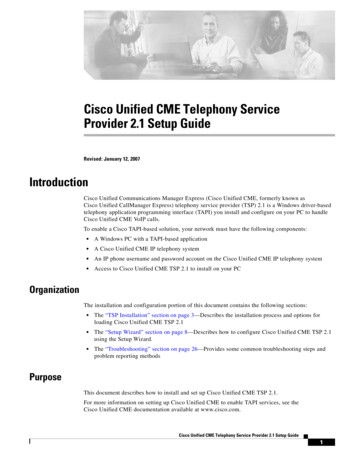
Transcription
DISCUSSION PAPER“Systems-Integrated CME”: The Implementationand Outcomes Imperative for Continuing MedicalEducation in the Learning Health Care EnterpriseDavid W. Price, MD, University of Colorado Anschutz School of Medicine and theAmerican Board of Family Medicine; David A. Davis, MD, AXDEV Group, Universityof Toronto, and Mohammed Bin Rashid University of Medicine & the HealthSciences; and Gary L. Filerman, MHA, MA, PhD, Atlas Health FoundationOctober 4, 2021IntroductionHealth care delivery has evolved from a variably connected collective of individually owned proprietorshipsand independent hospitals to an environment in whichphysicians increasingly contract with or are employedby health care enterprises. While continuing medicaleducation (CME) that is focused on the disseminationand maintenance of medical knowledge and the development of skills plays a critical role in helping physicians keep up to date, the authors of this manuscriptbelieve the structure and delivery of CME have not sufficiently evolved to be broadly viewed by health enterprise leaders as a strategic or integral asset to improving health care delivery. Therefore, an evolution anda reconceptualization of the structure and function ofCME are necessary to enable collaboration betweenleaders and improvement experts in health care enterprises and CME. In this paper, the authors describemodels that better reflect a more effective role of CMEwithin learning health care delivery enterprises andthe implications of such models for these enterprisesand the CME profession.Background: The Context of Health Care“CME is not keeping up with other methods thataddress identified gaps, align with outcome objectives, and address medical cognition. Systems likeours are making significant intellectual and financial investments in these [other] methods.”— Stephen R. T. Evans, MD, executive vice president, medical affairs and chief medical officer,MedStar Health (personal communication)Perspectives Expert Voices in Health & Health CareThe delivery of patient care services is increasinglybased in health care enterprises. These entities includehospitals in relationships with consolidated systems orchains, investor-owned practices, managed care organizations, accountable care organizations, medicalhomes, retail clinics, community health centers, andurgent care and surgical centers, among others. Fourdecades ago, care was delivered primarily by independent hospitals, independent physician’s office practices, and specialty group practices and reimbursedin a predominantly fee-for-service payment model. Incontrast, today’s physicians are increasingly employedor affiliated with health care enterprises through contractual relationships. A 2018 Health Affairs blog reported a near doubling of the percentage of primarycare physicians and specialists in practices owned byhospitals or health systems [1]. A 2018 American Medical Association Physician Practice Benchmark Surveyfound that “2018 marked the first year in which therewere fewer physician owners of their practices (45.9percent) than employees (47.4 percent)” [2], a trendthat has continued according to the 2020 survey [3]. Arecent JAMA report noted that 355 physician practices,crossing multiple specialties and including 1,426 sitesand 5,714 physicians, were acquired by private equityfirms from 2013–2016; the number of acquisitions increased each year from 59 in 2013 to 136 in 2016 [4].While the operational definitions of “private practice”and “physician employment” are not consistent in theliterature, the direction and pace of practice-settingchanges are clear.Health care enterprises are increasingly focused onthe “Triple Aim” of health care (improving populationhealth, effective stewardship of health care resources,
DISCUSSION PAPERand improving the patient care experience) [5]. Theyare also increasingly focusing on the appropriatenessof care and avoiding overuse. Overuse refers to theprovision of medical care or services that offer little orno evidence of benefit to patients and are duplicative,potentially or outright harmful, or unnecessary [6]. According to a report of the Institute of Medicine (IOM;now the National Academy of Medicine) [7], unnecessary services comprise the single largest source ofwaste in US health care, amounting to roughly a thirdof health care expenditures. Misuse is defined as failure to execute clinical care plans and procedures properly [8], potentially resulting in needless delays in treatment or patient harm. Overuse and misuse also exposepatients to unnecessary harm. Time and resourcesspent on the overuse of some medical services diverttime and attention from other interventions, leading tounderuse of appropriate resources (many immunizations, for example) in large segments of the population(particularly those in underserved areas) [9]. In addition to a plethora of data collected from processes andoutcomes of care, health care enterprises are increasingly examining patient-reported outcome measures,defined as “any report of the status of a patient’s (orperson’s) health condition, health behavior, or experience with health care that comes directly from the patient, without interpretation of the patient’s responseby a clinician or anyone else” [10]. Health care enterprises are also assessing patient experience of careusing measures such as Press Ganey [11], ConsumerAssessment of Healthcare Providers and Systems [12],and the Hospital Consumer Assessment of HealthcareProviders and Systems [13] surveys. Patient experienceis a component of the Centers for Medicare and Medicaid Value-Based Purchasing Program [14]. Improvedlevels of patient engagement have been shown to correlate with improved health care outcomes [15,16].CME can help physicians and health care enterprisesachieve the Triple Aim and improve the patient experience. In this paper, the authors articulate a vision fora more strategic role for CME within health care enterprises. The authors, who have substantive experiencein CME development, delivery, and evaluation (DWP,DAD) and CME governance (DWP, GLF) also describeframeworks that CME professionals and health careenterprise leaders can collaboratively use to achievethese goals.The Reality and Potential of CMEPhysician education begins with four years of under-Page 2graduate (medical school) training, followed by graduate medical education (residency and sometimes fellowship) that lasts from three to as many as ten years.In addition, CME offers “educational activities whichserve to maintain, develop, or increase the knowledge,skills, and professional performance and relationshipsthat a physician uses to provide services for patients,the public, or the profession” [17,18].The CME system recognizes that physicians shouldcontinue to learn over the ensuing decades of theircareers. It assumes that physicians should be able topursue their own learning interests based on their specialty and practice situation as part of professional selfregulation. The CME system developed gradually overthe first part of the twentieth century, gained momentum after World War II, and became more formalized,including the development of systems of accreditationof continuing education providers, starting in the late1960s [19,20]. Accreditation “attempts to confirm thequality and integrity of accredited CE [continuing education] by establishing criteria for the evaluation ofthe providers, assessing whether accredited providersmeet and maintain minimum standards, and promoting CME provider self-assessment and improvement”[21]. While not all physician educational events or materials are accredited, those that are have demonstrated adherence to standards for planning, mitigation ofbias, and delivery.In its earliest stages, hospital rounds, conferences,meetings, and journals allowed physicians to keepabreast of advances in medical science. Since then,CME has advanced to include a wider array of modalities for educational delivery—e.g., videos, podcasts,self-assessment programs, simulation centers, pointof-care learning, interprofessional team training, andother online education, all of which have been evenfurther accelerated by the COVID-19 pandemic. In addition, CME has evolved to include active learning strategies, incorporation of theory and evidence from thelearning sciences, emphasis on educational activitiesbased on data-defined gaps in care delivery, post-educational assessments of physician intent or commitment to change [22,23], and emphasizing outcomes ofcare in addition to changes in knowledge.Fifteen years ago, the Conjoint Committee on Continuing Medical Education (CCCME) undertook a threeyear initiative to “explore, agree on, and proposechanges to the present CME system” [24]. The committee, composed of 14 major stakeholders in CME,conducted its work at the height of public and profes-Published October 4, 2021
“Systems-Integrated CME”: The Implementation and Outcomes Imperativefor Continuing Medical Education in the Learning Health Care Enterprisesional attention to the IOM’s seminal reports, “To ErrIs Human” [25] and “Crossing the Quality Chasm” [26].The CCCME report addressed aspects of licensure andboard certification but did not explicitly mention therole of CME. Rather, it focused on the physician userand reporting and credit management aspects butfailed to recognize the emerging changes in practiceand the impact of those changes on CME. Hospitalsand health care systems were only minimally represented on the committee.Five years later, the IOM report “Redesigning Continuing Education in the Health Professions” [27] identified flaws in the structure and scientific underpinnings of continuing health professions education. Itcalled for increased emphasis on interprofessional education and offered the possibility of better alignmentbetween health care enterprise needs and CME. Thisreport painted a new vision for continuing professionaldevelopment, suggesting that health care enterprisesappoint “a chief learning officer who would design andoversee a system of interprofessional, team-basedlearning that focuses on the delivery of evidence-basedhealth care” [28]. Since the report, there has been anincreased emphasis on interprofessional continuingeducation, including pathways for organizational interprofessional education accreditation. There havealso been examples in some academic medical centersor integrated systems like Kaiser Permanente, whereCME has a defined role in organizational improvement.However, a lack of alignment or integrated workingrelationship between CME and the improvement apparatus in many health enterprises continues to exist,even in health care enterprises that have an accreditedCME unit.CME continues to face several challenges. Tailoringeducation to a local practice environment is difficultwhen relevant, actual practice data is unavailable orinsufficiently granular. Physicians largely believe theycan accurately assess their learning needs [28] despite evidence to the contrary [29,30]. As such, theyfrequently select their educational activities based onself-perceptions of need instead of being guided by objective performance data. Despite evidence on the limited ability to impact practice, passive, single-session,and largely didactic activities are still common. Assessing outcomes beyond provider satisfaction, pre/postassessments of knowledge, or commitment to changeis time-consuming and may be logistically or methodologically challenging and is thus underutilized. Creditsfor participation in learning activities are still largelyNAM.edu/Perspectivesdetermined by counting hours of learning time, ratherthan credit being awarded based on measurement ofpractice process changes or outcomes. Perhaps forthese reasons, leaders of health care enterprises commonly perceive that CME is somewhat peripheral tothe practice of medicine and the delivery of evidencebased care. Insufficiently few health care enterpriseleaders have embraced CME as a strategic asset orchange agent to help them meet their improvementand “Triple Aim” goals.CME has historically focused on dissemination andmaintenance of physician knowledge (“what to do”) anddevelopment of skills (“how to do it”). This focus continues to play an important and necessary role in servingthe profession of medicine by providing a means forphysicians to update their medical knowledge, pursuetheir learning interests and needs, and meet licensing,credentialing, and board certification requirements.Statewide and national organizations (e.g., state andnational medical societies, medical specialty societies) will continue to play important roles in CME, particularly for physicians in independent practice and forspecialty-specific content knowledge, procedural skills,and some aspects of state and national health policy.However, the importance of tailoring CME to the local practice context will increase, especially given theincreasing prevalence of relationships between physicians and health care enterprises. The authors of thismanuscript believe a broader conceptualization andfocus on the structure, function, design, and deliveryof CME is necessary to better improve the quality, cost,and experience of patient care. Adequate and currentcontent knowledge is necessary for ongoing care improvement. Consistent with outcomes frameworksproposed by Miller [31], Kirkpatrick [32], and Moore[33], CME providers will need to prioritize facilitatingsustained clinical behavior change in the local healthcare enterprise environment. Health care enterpriseleaders will then need to facilitate explicit inclusion ofCME into their change and improvement apparatus.Yet, a recent survey of 26 different individuals working in CME highlighted a continued prioritization ofknowledge-based, single educational activities over facilitating practice change [34]. In the sections that follow, the authors illustrate the gaps in coordination andalignment between CME and the health care deliveryenterprise. The authors discuss how concepts fromthree different models of translating evidence intopractice can be adapted to facilitate better integrationof CME and health enterprise goals and strategies. ThePage 3
DISCUSSION PAPERauthors then discuss the implications of these new directions for the training and job expectations of CMEprofessionals and the application of new skills. Finally,the authors discuss the implications of these new directions for health enterprise leadership.Integrating Health Care Delivery and CMEThe following quotes (personal communications) fromhealth care enterprise executive leaders exemplify theperceived lack of coordination and alignment betweenCME and the needs of their enterprises.“I really like the idea of CME as a management toolthat is integrated into and aligned with the strategic plan of the organization. Now our CME is aperk to fund the interest of the individual physicianvs. being aligned with the strategy of the organization. A minority of the education has limited valueto our organization.”— Douglas P. Cropper, MHA, President andCEO, Genesis Health System“In the thirty-three years that I served as CEO andPresident of the 310-bed Chesapeake RegionalMedical Center, we required CME for staff membership. It was never related to a clinical deficiencyor to strategic planning. We used internal andexternal benchmarks for quality improvement butdid not relate it to CME programming.”— Donald S. Buckley, MHA, PhD, PresidentEmeritus, Chesapeake Regional Medical Center“What is needed is a mechanism whereby CMEprogramming can tangibly demonstrate its relevance and contribution to the strategic needs ofthe organization as it carries out its mission andserves the community.”— Thomas M. Priselac, MPH, President andCEO, Cedars-Sinai Health SystemIn order to frame the following section, the authors offer a vignette:The physician director of the CME Department in astatewide health care system has been informed thather department is being eliminated because of system-wide budget cuts necessitated by the COVID-19pandemic. While appealing the decision to the systempresident, she was asked to show how departmentsponsored CME activities have improved patient care.She describes two activities over the last two yearsPage 4where CME outcomes have been associated withimprovements in care quality. The system presidentagrees to restore the department budget for one additional year, with the expectation that the departmentwork with system improvement leaders and tangiblydemonstrate its value in improving the outcomes,costs, and patient experience of care.Over the past twenty years, the CME community hasmade progress incorporating the science of learninginto educational planning. While this is an importantand necessary evolution, the conceptualization, organization, focus, and delivery of CME must continue toadapt for the field to meet its potential of contributing to sustained improvements in patient health. CMEneeds to attend to the dynamic changes in the relationship of physicians with continually evolving healthcare enterprises. Enterprise-based CME professionalsneed to demonstrate value by designing and delivering gap-specific, theory- and evidence-grounded educational activities tailored to the context, culture, andoperational structure of their specific health care enterprises. In turn, health care enterprise leaders needto financially support and facilitate necessary collaborations for these efforts. The objective should beto collaborate more effectively within health care enterprises to achieve integration with the enterprise’sperformance improvement plans. The challenges areto objectively demonstrate and document the value ofCME from the quality, cost, and service frame of reference of enterprise leaders and provide enterprise leadership with adaptable frameworks for implementing itsapplication.Several implementation-science-related models offer frameworks for an integrated role of CME in healthcare enterprises. These models provide a basis for abroader, multistakeholder development and evaluation of CME’s contribution to improved health ofpatients and populations. Previous authors have described how educators can use constructs from quality improvement, complex adaptive systems, diffusionof innovations, stages of change, knowledge-to-action,and other models [35,36,37,38]. In the section thatfollows, the authors highlight three additional frameworks that can be used as CME and health systems enterprises become more aligned in addressing gaps inhealth care. A single tool might be used, or differentelements of these tools could be “mixed and matched,”depending on the specific intervention and opportunities to align with enterprise operational units.Published October 4, 2021
“Systems-Integrated CME”: The Implementation and Outcomes Imperativefor Continuing Medical Education in the Learning Health Care EnterpriseStrategies to Facilitate Better Integration ofCME and the Health EnterpriseRedesigning CME InterventionsCME providers frame their work in terms of educational activities [39]. Many of these educational activitiesare developed and delivered as single-session topicsor as collections of related but still individualized topics delivered at a point in time (e.g., conferences withconcurrent sessions), over a period (e.g., tumor boardsdiscussing different cancers), or in print or other enduring modalities. The authors observe that current,aggregated educational data are not specific enough todetermine the frequency or degree to which activitiesreview previous learnings and build off one another(scaffolding). CME could provide added value to healthcare and health care enterprises if efforts were delivered as educational interventions or initiatives drivenby and supporting the work of organizational leaders,including those responsible for improvement in safety,quality, cost and patient experience. These CME effortscould be conceptualized as longitudinal efforts similarto repeated Plan-Do-Study-Act (PDSA) cycles [40]. Datafrom different sources (electronic health records, utilization data, insurance claims, public health and diseaseregistries, medical literature, governmental quality reports, etc.) and individual and team performance dataare analyzed to identify opportunities for improvement(“gaps” in the processes or outcomes of care). If analysis reveals deficits in individual or team knowledge orcompetence, then data-informed multimodal, longitudinal, interactive educational interventions are conducted. Education is followed by guided, longitudinalinterventions allowing individuals and teams to applyand implement what they have learned in practice. Ifanalysis does not reveal knowledge or competencegaps, educational activities step can be skipped, butguided implementation activities will still be necessary.Implementation activities are evaluated using the samedata sources that identified the gap. The cycle continues, similar to iterative PDSA cycles, until unwarrantedpractice variation is reduced, and applicable “TripleAim” outcomes are achieved. Involving physicians andother team members throughout the process couldhelp streamline their work, engender engagementand buy-in with enterprise goals, and could contributeto enhanced physician/staff satisfaction (see Figure 1)[41]. Logic models graphically represent the sharedrelationships among the resources, activities, outputs,and outcomes or impacts for an initiative [42,43,44].NAM.edu/PerspectivesTheories of change explain how an intervention is expected to produce its desired results [45,46]. The authors recommend more frequently using theories ofchange and logic models to explain the role of CME inimprovement interventions, guide the development ofCME activities, and assess CME’s contribution to theoutcomes improvement efforts.Improving Descriptive Measures and TermsBecause CME is delivered in so many different contexts, the descriptive and evaluative lexicon used inCME is broad. While there are necessary trade-offs between flexibility (for context) and standardization (forcomparison), the less well-defined CME descriptionsand reporting terms (e.g., longitudinal, interactive) are,the greater the variability of their interpretation anduse among CME providers and between CME providersand enterprise leadership. Common and specific definitions for terms, along with descriptions of the context in which they are delivered, would greatly enhancecomparison among educational efforts and their relationship or contribution to outcomes of care.Some metrics used in CME reporting (e.g., number ofcredits earned) appear straightforward, but problemsoccur in their interpretation, as credits earned are often based on attendee self-report of sessions attended, without measures of engagement. Other reportingterms are even less standardized and more subjectiveand are subject to high levels of inter-rater variability.For example, providers of accredited CME self-reportwhether their activities are designed to change practice. While several systematic reviews broadly outlinethe qualities of CME that are likely to result in practicechange (longitudinal and sequenced sessions, reflective, interactive, feedback-based, multimodal, spaced,etc.) [47,48,49,50,51], to the knowledge of the authors,the degree to which this self-reported metric corresponds with actual use of these techniques is unclear.Additionally, CME providers likely differ in the criteriaused to classify an activity as interactive and reflective.High-level reporting does not currently differentiatebetween the number or intensity of successful educational practices used.There is not a simple solution to these definitionalchallenges. As a starting point, the authors suggest thatCME providers specify how their activities address theimprovement needs of the health care enterprise, meetdesign principles for effective CME, complement or reinforce other organizational improvement activities,and specifically define the measures they are using inPage 5
DISCUSSION PAPERFIGURE 1 A Longitudinal Model for CME in Health SystemsDerived from: Price, D. 2017. Maintenance of Certification, Continuing Professional Development, and Performance Improvement. In: Rayburn, W., M. Turco, and D. A. Davis (eds). Continuing Professional Developmentin Medicine and Health Care: Better Education, Better Patient Outcomes. Philadelphia PA, Wolters Kluwer. Figureadapted with the permission of the American Board of Medical Specialties and the American Board of MedicalSpecialties Research and Education Foundation.activity evaluation. Subsequent qualitative analyses ofthese narrative comments could lead to development,testing, and refinement of more specific definitions ofthese terms for aggregate reporting.Employing CME in Complex Adaptive Health CareEnterprisesHealth care delivery enterprises are complex adaptive systems, with varied interrelationships betweenindividuals and groups with differing perspectives andbaseline knowledge and skills necessary for change[36,52,53]. A few desired improvements in health careorganizations (e.g., introduction of an electronic healthrecord alert to avoid antibiotic-warfarin drug-drug interactions) may be relatively simple or straightforward.Although implementation may take time (to reverseestablished behaviors), simple improvements generally have evidence-based and widely agreed-upon solutions, relatively few interdependencies, and little if anyneed for customization of implementation. On the other hand, some improvements (e.g., implementation ofa laparoscopic instead of an open surgical procedure)may be more complicated. In these cases, the technicalPage 6aspects of performing the procedure for the surgeonmay be evidence-based and clear, but implementationmay require changes in workflow or affect specialtiesor disciplines differently.Many desired health care enterprise improvements(e.g., implementation of new treatment pathways) arecomplex. These may entail reconciling differences inguidelines or evidence interpretation; responding todifferences between national guidelines and enterpriseregulations (e.g., medication formulary issues); and coordination, communication, and collaboration betweendifferent medical specialties or between physiciansand other health care professionals. These improvements require multilayered, multifaceted, tailored, andlongitudinal approaches. The authors contend that enterprise-embedded CME is better positioned than CMEoffered to wide and diverse (e.g., national) audiences tohelp operationalize and tailor known evidence, guidelines, successful practices (the “what” and “the how”)into the context and culture of health care organizations and units (“how to do the how”).Published October 4, 2021
“Systems-Integrated CME”: The Implementation and Outcomes Imperativefor Continuing Medical Education in the Learning Health Care EnterpriseCME and Learning Health Systems“Knowing is not enough, we must do. Willing is not enough,we must apply.” — Johann Wolfgang von GoetheThe National Academy of Medicine defines a continuously learning health system as “one in which science,informatics, incentives, and culture are aligned for continuous improvement and innovation, with best practices seamlessly embedded in the care process, patients and families active participants in all elements,and new knowledge captured as an integral by-productof the care” [54]. Learning health systems have a leadership-instilled culture of learning. They use real-timeaccess to data and evidence and partner with patientsand families to improve care. They incent transparent efforts to continually improve and offer high-valuecare. In addition, learning health systems employ teamtraining and skill building, systems analysis, and ongoing feedback for continuous learning and system improvement [7].Individuals must be engaged, learn, and evolvefor the health care enterprise to grow and improve[55,56,57,58]. The success of organizational learningis judged by observable behavioral change, not solelyon cognitive changes [59]. By partnering with otherenterprise personnel (e.g., human resources, processimprovement, and data analysis experts), initiative- orintervention-based CME emphasizing individual andteam-based knowledge and skill development couldmake significant contributions to the development oflearning health care organizations. Several existingframeworks can be used to help organizational CMEevolve for this purpose.Frameworks for an Implementation ScienceApproach to CME in Learning Health EnterprisesImplementation science is the study of methods to promote the adoption and integration of evidence-basedpractices and policies into routine health care and public health settings to improve population health. Implementation science uses theories, models, principles,research designs, and methods derived from multipledisciplines and industries outside of medicine (e.g.,organizational development, quality improvement, industrial engineering, business management, social science). Partnerships with key stakeholder groups (e.g.,patients, providers, organizations, health systems, orcommunities) are critical in the application of implementation science [60,61]. Medical educators andNAM.edu/Perspectiveshealth system leaders are increasingly turning to animplementation science lens to help frame and evaluate the impact of their work.Conceptual frameworks are used to develop andevaluate multifaceted interventions. Building uponprevious research (often outside of medicine), theseframeworks describe and explain concepts, assumptions, expectations, key factors, constructs, and variables that may influence an outcome of interest [62].The use of conceptual frameworks may increase thegeneralizability of findings. Below, the authors describethree frameworks derived from implementation science that can be used to conceptualize, design, implement, and evaluate CME integrated into health enterprise improvement.The Consolidated Framework for ImplementationRes
or integrated systems like Kaiser Permanente, where CME has a de fi ned role in organizational improvement. However, a lack of alignment or integrated working relationship between CME and the improvement ap-paratus in many health enterprises continues to exist, even in health care enterprises that have an accredited CME unit.


